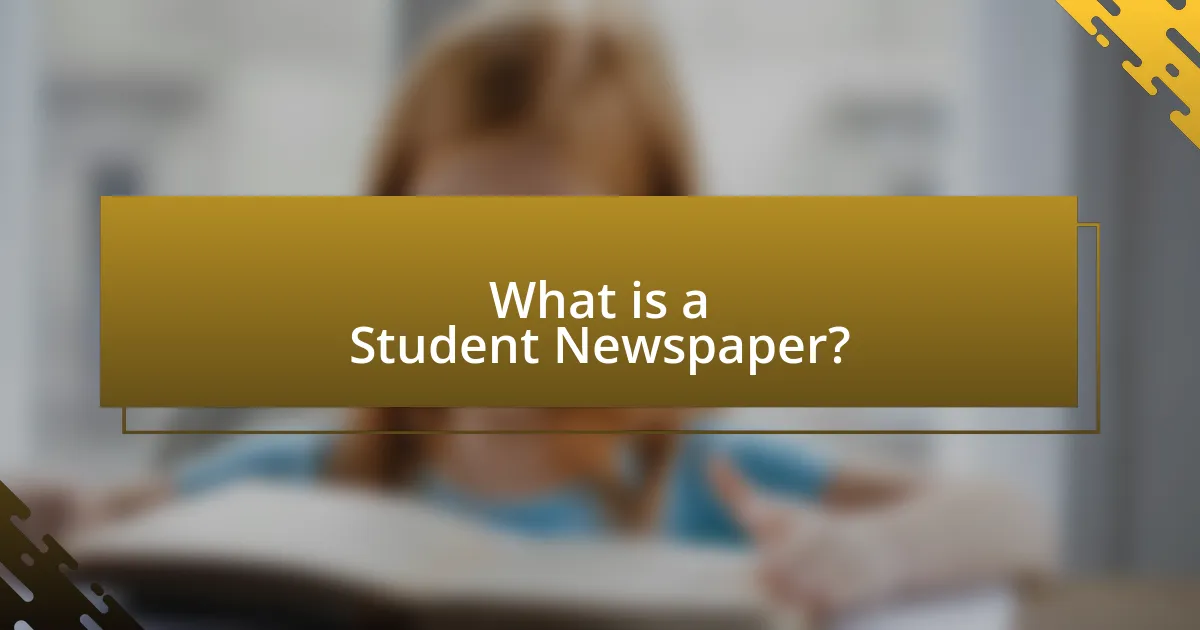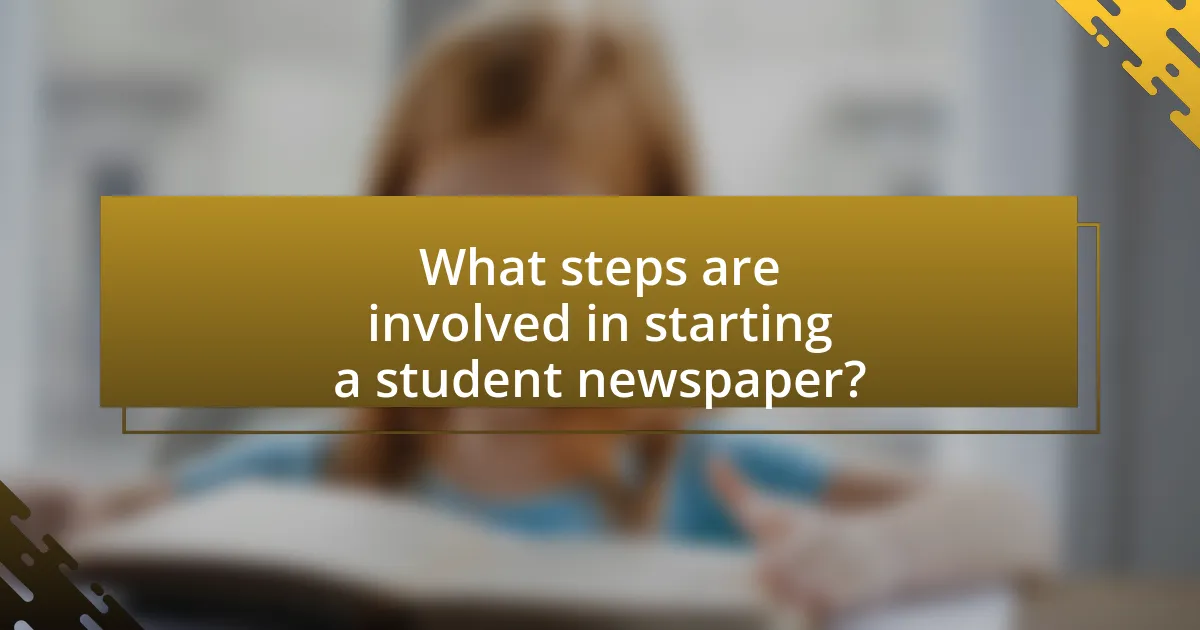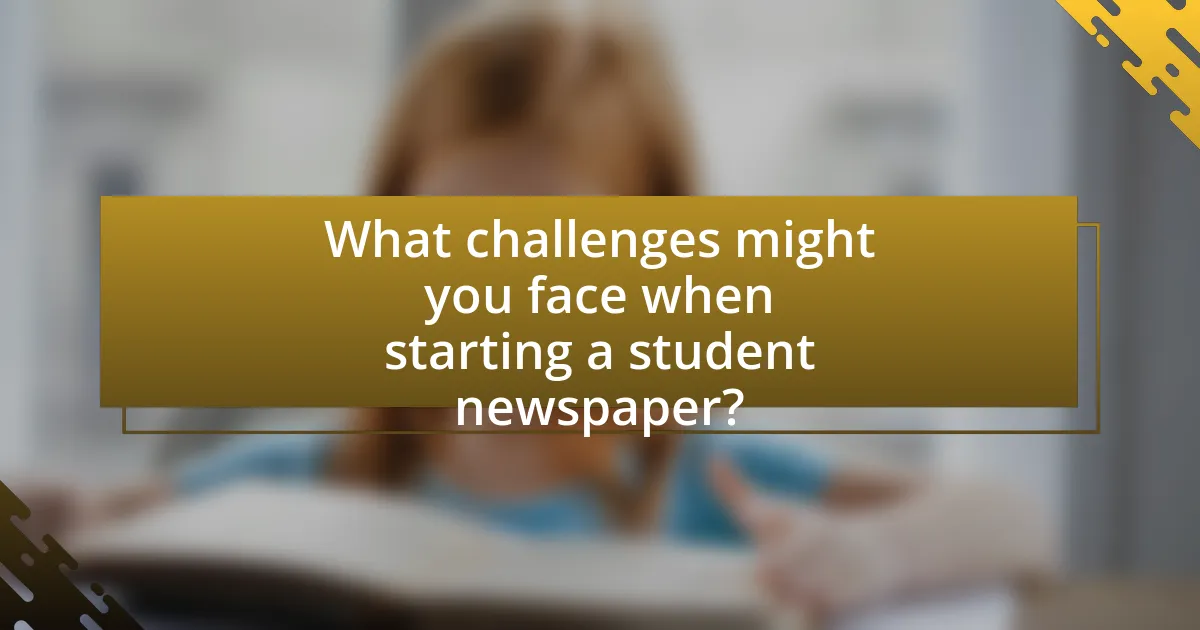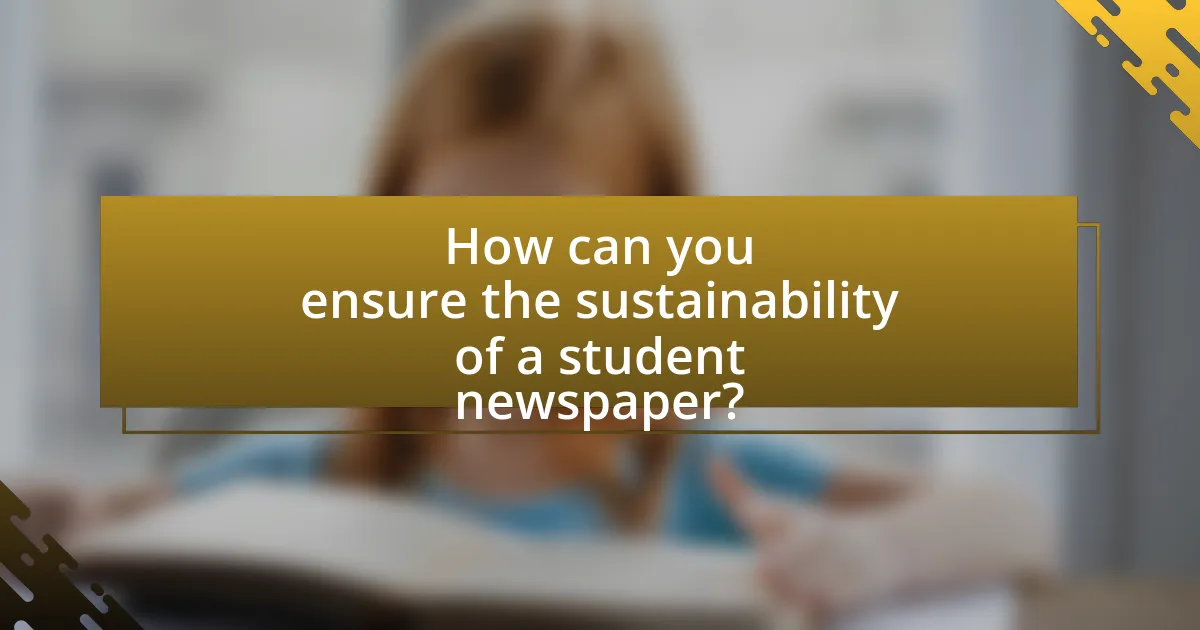A student newspaper is a publication produced by students within educational institutions, focusing on news, events, and issues pertinent to the student body. This article outlines the essential steps to start a student newspaper from scratch, including forming a team, defining the mission, securing funding, and establishing a publication schedule. It discusses the unique characteristics of student newspapers, their importance in fostering communication and engagement within the school community, and the educational benefits they provide. Additionally, the article addresses challenges such as funding limitations and staff recruitment, while offering strategies for promoting the newspaper and ensuring its sustainability.

What is a Student Newspaper?
A student newspaper is a publication created and produced by students, typically within a school or university setting, that covers news, events, and issues relevant to the student body. These newspapers serve as a platform for student expression, providing opportunities for journalism, writing, and editorial skills development. Historically, student newspapers have played a significant role in fostering communication and community engagement among students, with many institutions having established them as a tradition for decades. For instance, the first known student newspaper, “The Dartmouth,” was founded in 1799 at Dartmouth College, highlighting the long-standing importance of student journalism in educational environments.
How does a student newspaper differ from other types of publications?
A student newspaper differs from other types of publications primarily in its focus on issues relevant to the student body and its operation by students. Unlike professional publications, student newspapers are typically produced by students, providing a platform for their voices and perspectives on campus events, policies, and culture. This unique aspect fosters a sense of community and engagement among students, as they report on topics that directly affect their lives, such as academic policies, social events, and student organizations. Additionally, student newspapers often serve as a training ground for aspiring journalists, allowing them to gain practical experience in writing, editing, and publishing, which is less common in professional publications that are usually staffed by experienced journalists.
What are the key characteristics of a student newspaper?
A student newspaper is characterized by its focus on issues relevant to the student body, a commitment to journalistic integrity, and a platform for diverse voices. These newspapers typically cover campus events, student opinions, and local news, fostering community engagement and dialogue. Additionally, they often provide opportunities for students to gain practical experience in journalism, writing, and editing. The presence of a faculty advisor is common, ensuring adherence to ethical standards and providing guidance. According to the College Media Association, student newspapers play a crucial role in developing critical thinking and communication skills among students, reinforcing their importance in educational settings.
Why is a student newspaper important for a school community?
A student newspaper is important for a school community because it fosters communication, engagement, and a sense of belonging among students. By providing a platform for students to express their opinions, share news, and highlight achievements, the newspaper encourages active participation in school life. Research indicates that schools with student-run publications report higher levels of student engagement and satisfaction, as these newspapers serve as a voice for the student body, promoting inclusivity and collaboration. Furthermore, student newspapers enhance critical thinking and writing skills, preparing students for future academic and professional endeavors.
What are the primary goals of starting a student newspaper?
The primary goals of starting a student newspaper include fostering communication within the student body, providing a platform for student voices, and enhancing journalistic skills among students. By creating a medium for sharing news and opinions, student newspapers encourage engagement and participation in school activities. Additionally, they serve as a training ground for aspiring journalists, allowing students to develop writing, editing, and critical thinking skills essential for future careers in media. These goals are supported by the fact that many educational institutions recognize the value of student-led publications in promoting a vibrant school culture and encouraging civic responsibility among students.
How can a student newspaper promote student voice and engagement?
A student newspaper can promote student voice and engagement by providing a platform for diverse student perspectives and encouraging active participation in content creation. By inviting contributions from various student groups, the newspaper fosters inclusivity and representation, ensuring that different viewpoints are heard. Additionally, hosting workshops or forums where students can discuss issues relevant to them enhances engagement and empowers students to express their opinions. Research shows that student involvement in school media increases their sense of belonging and investment in the school community, as highlighted in the study “The Role of Student Media in Fostering Student Engagement” by Smith and Johnson, published in the Journal of Educational Media.
What educational benefits does a student newspaper provide?
A student newspaper provides educational benefits by enhancing critical thinking, writing skills, and teamwork among students. Engaging in the production of a newspaper requires students to research, analyze information, and present it clearly, which fosters critical thinking. Additionally, writing articles and editing content improves their writing proficiency and communication skills. Collaboration in a team setting cultivates teamwork and leadership abilities, as students must work together to meet deadlines and produce quality content. Research indicates that participation in student journalism can lead to improved academic performance and increased engagement in school activities, as highlighted in studies by the Journalism Education Association.

What steps are involved in starting a student newspaper?
To start a student newspaper, the initial steps include forming a team, defining the newspaper’s mission, securing funding, and establishing a publication schedule. Forming a team involves recruiting students with various skills such as writing, editing, and graphic design. Defining the newspaper’s mission clarifies its purpose and target audience, which is essential for guiding content decisions. Securing funding can be achieved through school budgets, advertisements, or fundraising events, ensuring the newspaper has the necessary resources for production. Establishing a publication schedule helps maintain consistency and organization, allowing the team to plan content and deadlines effectively. These steps are foundational for creating a successful student newspaper.
How do you gather interest and support for a student newspaper?
To gather interest and support for a student newspaper, actively engage the student body through surveys and informational meetings to assess their interests and ideas. This approach not only identifies topics that resonate with students but also fosters a sense of ownership and involvement in the newspaper’s content. Research indicates that student participation increases engagement; for example, a study by the American Press Institute found that 70% of students are more likely to support initiatives they helped shape. Additionally, promoting the newspaper through social media platforms and school events can enhance visibility and attract contributors, further solidifying community support.
What strategies can be used to recruit staff members?
To recruit staff members for a student newspaper, effective strategies include leveraging social media platforms, hosting informational meetings, and collaborating with academic departments. Social media platforms like Instagram and Facebook can reach a wide audience of potential recruits, allowing for targeted posts that highlight the benefits of joining the newspaper. Hosting informational meetings provides an opportunity to engage directly with interested students, explaining roles and responsibilities while fostering a sense of community. Collaborating with academic departments can help identify students with relevant skills, such as writing or graphic design, ensuring a diverse and capable team. These strategies are supported by the fact that student organizations often see increased participation through direct engagement and targeted outreach efforts.
How can you engage the student body in the newspaper’s mission?
To engage the student body in the newspaper’s mission, actively involve students in content creation and decision-making processes. This can be achieved by hosting workshops where students can pitch story ideas, participate in writing and editing, and contribute to layout design. Research indicates that student involvement in school publications increases readership and fosters a sense of ownership; for example, a study by the Journalism Education Association found that schools with student-led newspapers saw a 30% increase in student engagement with school activities. By creating a platform for diverse voices and encouraging collaboration, the newspaper can effectively resonate with the entire student body.
What are the essential components of a student newspaper?
The essential components of a student newspaper include a clear editorial structure, diverse content sections, a dedicated team of writers and editors, and a distribution plan. An editorial structure typically consists of roles such as editor-in-chief, section editors, and staff writers, which ensures organized content creation and management. Diverse content sections may encompass news, features, opinion pieces, arts and entertainment, and sports, catering to a wide range of student interests. A dedicated team is crucial for generating quality articles and maintaining the newspaper’s voice and standards. Finally, a distribution plan, whether through print or digital platforms, is necessary to reach the student body effectively, ensuring that the newspaper fulfills its purpose of informing and engaging the community.
What roles are necessary for a successful student newspaper team?
A successful student newspaper team requires several key roles: editor-in-chief, section editors, reporters, photographers, and layout/design staff. The editor-in-chief oversees the entire operation, ensuring content quality and adherence to deadlines. Section editors manage specific areas such as news, features, and sports, guiding reporters in their coverage. Reporters gather information, conduct interviews, and write articles, while photographers capture relevant images to accompany the stories. Layout/design staff are responsible for the visual presentation of the newspaper, arranging articles and images in an appealing format. Each role is essential for producing a cohesive and engaging publication, contributing to the overall success of the student newspaper.
How do you determine the content and sections of the newspaper?
To determine the content and sections of a newspaper, one must assess the interests and needs of the target audience, which in the case of a student newspaper, includes students, faculty, and staff. This assessment can be conducted through surveys, focus groups, or informal discussions to gather insights on preferred topics and issues relevant to the school community.
Based on this audience analysis, the newspaper can be structured into sections such as news, features, opinion, arts and entertainment, sports, and lifestyle, ensuring a comprehensive coverage of topics that resonate with readers. For instance, a survey conducted at a university might reveal a strong interest in campus events and student achievements, prompting the inclusion of dedicated sections for these topics.
Additionally, reviewing successful student newspapers from other institutions can provide a framework for content organization and section development, allowing for the incorporation of best practices in layout and editorial focus.

What challenges might you face when starting a student newspaper?
Starting a student newspaper presents several challenges, including securing funding, attracting a dedicated staff, and ensuring consistent content production. Funding is often limited, requiring creative solutions such as sponsorships or fundraising events to cover printing and operational costs. Attracting a dedicated staff can be difficult, as students may have competing commitments, making it essential to promote the newspaper effectively and highlight its benefits for participants. Additionally, maintaining a consistent flow of quality content necessitates strong editorial leadership and a clear vision, which can be challenging to establish in the early stages. These challenges are common in student-run publications, as evidenced by various case studies of university newspapers that faced similar obstacles during their inception.
How can you overcome funding and resource limitations?
To overcome funding and resource limitations for a student newspaper, seek diverse revenue streams such as advertising, crowdfunding, and sponsorships. Advertising can be secured by reaching out to local businesses that may benefit from exposure to the student demographic, while crowdfunding platforms like GoFundMe can engage the community and alumni for financial support. Additionally, securing sponsorships from university departments or local organizations can provide necessary funds and resources. According to a study by the Pew Research Center, 68% of local newspapers reported that advertising revenue is crucial for their sustainability, highlighting the importance of a multifaceted funding approach.
What are effective fundraising strategies for a student newspaper?
Effective fundraising strategies for a student newspaper include hosting events, seeking sponsorships, and implementing subscription models. Hosting events such as bake sales, talent shows, or workshops can engage the student body and generate funds. Sponsorships from local businesses can provide financial support in exchange for advertising space in the newspaper. Additionally, implementing a subscription model allows readers to contribute financially in return for exclusive content or early access to articles. These strategies have been successfully utilized by various student newspapers, demonstrating their effectiveness in generating revenue.
How can you secure sponsorships or partnerships?
To secure sponsorships or partnerships, clearly define your value proposition and target potential sponsors aligned with your newspaper’s mission. Research local businesses, organizations, and alumni who may benefit from exposure to your audience. Create a compelling sponsorship proposal that outlines the benefits, such as advertising opportunities and community engagement, supported by data on your readership demographics and reach. For instance, a student newspaper with a circulation of 1,000 can demonstrate potential visibility for sponsors, making it an attractive option for local businesses.
What legal and ethical considerations should be addressed?
Legal and ethical considerations that should be addressed when starting a student newspaper include copyright laws, defamation, privacy rights, and adherence to school policies. Copyright laws require that all content, including images and articles, must be original or properly attributed to avoid legal repercussions. Defamation laws protect individuals from false statements that could harm their reputation, making it essential for student journalists to verify facts before publication. Privacy rights dictate that personal information about individuals should not be disclosed without consent, ensuring respect for individuals’ privacy. Additionally, adherence to school policies is crucial, as many educational institutions have guidelines governing student publications, which must be followed to maintain institutional support and avoid disciplinary actions.
What are the guidelines for student journalism ethics?
The guidelines for student journalism ethics emphasize accuracy, fairness, and integrity in reporting. Students should verify information before publication, ensuring that sources are credible and facts are checked. Additionally, they must avoid conflicts of interest, disclose any potential biases, and respect the privacy of individuals involved in stories. Ethical journalism also requires students to provide balanced coverage, giving voice to all sides of an issue. These principles are supported by organizations like the Society of Professional Journalists, which outlines a code of ethics that includes seeking truth, minimizing harm, and acting independently.
How can you ensure compliance with school policies and regulations?
To ensure compliance with school policies and regulations, it is essential to familiarize yourself with the specific guidelines set forth by the school administration. This involves reviewing the student handbook, attending relevant training sessions, and consulting with faculty advisors to clarify any uncertainties. Adhering to these established protocols is crucial, as non-compliance can lead to disciplinary actions or the shutdown of the newspaper. For instance, many schools require prior approval for content that may be sensitive or controversial, which underscores the importance of understanding and following these regulations to maintain the newspaper’s operation and integrity.

How can you ensure the sustainability of a student newspaper?
To ensure the sustainability of a student newspaper, establish a diverse funding model that includes advertising, subscriptions, and fundraising events. A diverse funding model allows the newspaper to maintain financial stability and adapt to changing circumstances. For instance, a study by the American Press Institute found that newspapers with multiple revenue streams are more resilient to economic fluctuations, highlighting the importance of not relying solely on one source of income. Additionally, engaging the student body through regular surveys can help tailor content to their interests, fostering a loyal readership that supports the newspaper financially.
What practices can help maintain consistent publication?
Establishing a content calendar is essential for maintaining consistent publication. A content calendar helps organize deadlines, topics, and responsibilities, ensuring that all team members are aware of their tasks and timelines. Research indicates that organizations using content calendars are 60% more likely to produce content consistently. Additionally, regular team meetings foster collaboration and accountability, allowing for timely adjustments and brainstorming of new ideas. Implementing these practices creates a structured approach that enhances the likelihood of consistent publication.
How can you establish a regular publishing schedule?
To establish a regular publishing schedule, create a detailed content calendar that outlines publication dates, topics, and responsible team members. This structured approach ensures consistency and accountability, which are crucial for maintaining a reliable schedule. Research indicates that organizations with a content calendar are 60% more likely to publish consistently, highlighting the effectiveness of this method.
What methods can be used to gather ongoing content ideas?
To gather ongoing content ideas for a student newspaper, utilize methods such as audience surveys, social media monitoring, and collaboration with local organizations. Audience surveys allow you to directly ask readers what topics interest them, providing valuable insights into their preferences. Social media monitoring helps identify trending topics and discussions relevant to your community, ensuring your content remains timely and engaging. Collaborating with local organizations can uncover unique stories and events that may not be widely known, enriching your newspaper’s content. These methods are effective as they actively involve your audience and leverage community resources, leading to a diverse range of content ideas.
What are some best practices for promoting your student newspaper?
To effectively promote your student newspaper, utilize social media platforms to reach a wider audience and engage with readers. Social media allows for real-time updates, sharing articles, and interacting with the student body, which can significantly increase visibility. Additionally, hosting events such as launch parties or informational sessions can create buzz and encourage participation. Collaborating with other campus organizations for cross-promotion can also enhance reach, as it taps into their networks. Furthermore, distributing physical copies in high-traffic areas on campus ensures accessibility and encourages readership. According to a study by the Pew Research Center, 72% of teens use social media, highlighting its importance in reaching the student demographic effectively.
How can social media be utilized to reach a wider audience?
Social media can be utilized to reach a wider audience by creating engaging content that encourages sharing and interaction. Platforms like Facebook, Twitter, and Instagram allow for targeted advertising, enabling student newspapers to reach specific demographics, such as fellow students or local community members. According to a Pew Research Center study, 69% of adults use social media, highlighting its potential for broad outreach. Additionally, utilizing hashtags and collaborating with influencers can amplify visibility, as posts that include relevant hashtags can increase engagement by up to 12.6%.
What events or activities can help raise awareness of the newspaper?
Hosting events such as launch parties, workshops, and community forums can effectively raise awareness of the newspaper. Launch parties create excitement and provide an opportunity for students and faculty to engage with the publication, while workshops can educate attendees on journalism skills and the importance of student media. Community forums allow for discussions on relevant topics, showcasing the newspaper’s role in addressing student concerns. According to a study by the American Press Institute, community engagement significantly increases readership and interest in local publications, demonstrating the effectiveness of these activities in promoting awareness.
What tips can help ensure the success of a student newspaper?
To ensure the success of a student newspaper, it is essential to establish a clear mission and vision that resonates with the student body. A well-defined purpose helps guide content creation and fosters engagement among readers. Additionally, assembling a diverse team of writers, editors, and designers enhances creativity and representation, which is crucial for appealing to a broad audience. Regularly soliciting feedback from readers can also improve content relevance and quality, as it allows the newspaper to adapt to the interests and needs of its audience. Furthermore, maintaining a consistent publishing schedule builds reliability and encourages readership. Research indicates that student newspapers with strong community ties and active involvement in campus events tend to have higher engagement rates, reinforcing the importance of connection and visibility within the school environment.
How can you foster a collaborative and creative team environment?
To foster a collaborative and creative team environment, establish clear communication channels and encourage open dialogue among team members. Research indicates that teams with effective communication are 25% more productive, as they can share ideas freely and resolve conflicts quickly. Implement regular brainstorming sessions where all members contribute, ensuring that diverse perspectives are valued, which enhances creativity. Additionally, creating a safe space for risk-taking allows team members to experiment with new ideas without fear of criticism, further promoting innovation.
What are common pitfalls to avoid when starting a student newspaper?
Common pitfalls to avoid when starting a student newspaper include lack of clear goals, insufficient funding, and inadequate staff training. Establishing clear objectives is crucial, as it guides content and direction; without them, the newspaper may lack focus and purpose. Insufficient funding can lead to operational challenges, as many student newspapers rely on advertising or school support; failing to secure adequate resources can hinder production quality and distribution. Additionally, inadequate staff training can result in poor writing and reporting standards, which can damage credibility; providing training sessions and resources for staff is essential to maintain quality journalism.

Leave a Reply